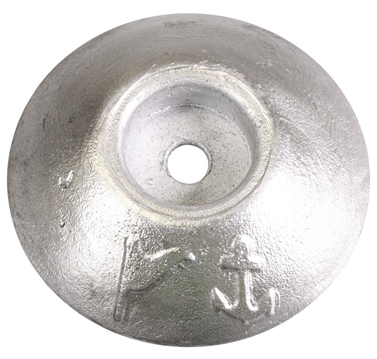Choosing the correct anodes
Selecting the correct anodes for your boat is essential for protecting metal components from galvanic corrosion.
Anodes, also known as sacrificial anodes, corrode in place of your boat’s metal parts, safeguarding the hull, propeller, and other underwater fittings from damage caused by electrolysis. Here’s a complete guide to help you choose and maintain the best anodes for your vessel.
Choose the Right Anode Material
Marine anodes are typically made from zinc, aluminum, or magnesium, and your choice should match the type of water you use your boat in:
- Zinc: best for saltwater environments.
- Aluminum: performs well in brackish water (a mix of salt and fresh water).
- Magnesium: ideal for freshwater and canal boats, offering excellent corrosion protection and great value for money.
For canal boats, magnesium anodes are strongly recommended — they are both cost-effective and perform exceptionally well in low-salinity conditions.

Placement:
Anodes should be strategically positioned along the hull to ensure even coverage and protection. They are typically installed at regular intervals, paying particular attention to areas prone to corrosion, such as the waterline, stern, bow, and near any fittings or welds.
Size and shape
Anodes come in various shapes and sizes, such as plates, rods, or pencil anodes. The size and shape should be appropriate for the area you intend to protect. It's important to follow the manufacturer's recommendations or consult with a marine specialist to ensure proper coverage and protection.

Lifespan
Anodes have a limited lifespan and will eventually wear out. Regular inspection and replacement of anodes are crucial to maintaining effective corrosion protection.
How many?
For steel-hulled boats, the number of anodes required depends on the size and configuration of the boat, as well as the specific conditions in which it will operate. Here are some general guidelines to consider when determining the number of anodes for a steel-hulled boat:
Hull Length
As a starting point, it is common to have at least one anode per metre or per 3-4 feet of hull length for steel boats. This provides a general coverage ratio, but it's important to consider other factors as well.
Hull Configuration
The shape and configuration of the hull can influence the number and placement of anodes. If the boat has a long keel, additional anodes may be required to protect this area. Similarly, if there are protruding parts or appendages like rudders, propellers, or bow thrusters, these areas may require their own dedicated anodes.
Remember, the number of anodes required is not the only consideration. Proper installation, regular inspection, and maintenance of anodes are also crucial to ensure their effectiveness. Anodes should be replaced when they have significantly corroded or worn down.
To determine the exact number and placement of anodes, it is recommended to consult with a marine professional or a qualified marine surveyor who has expertise in corrosion protection. They can provide tailored advice based on the specific characteristics and usage patterns of your vessel.



